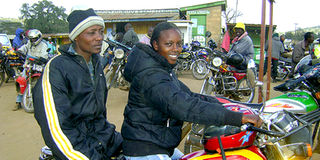Lessons for Kenya's 'boda boda' transport sector

Motor or tri-cycle bodaboda taxis provide the convenience of travelling irrespective of distance or destination. Above, Ms Celine Naitoti Lenkidi as she prepares to ferry a customer at the boda boda terminus in Maralal Town recently. Photo/FILE
What you need to know:
- Known for its versatility, tricycles play a crucial role in the Philippine transport sector
- Motorcycle-taxis on the other hand have extended seats and extra shock-absorbers added at the rear.
- Study: The major causes of tricycle accidents are identified to be: drivers’ attitude, sidecar fabrication, and tricycle stability.
With the emergent boom of motorcycle boda bodas (taxis) in major urban centres in the country, concerns over safety have increased.
This is just one concern among others that stakeholders in the country must take well into consideration in order to make this emerging sector a sustainable enterprise and one that has a great potential in easing the transport glitches in many urban centres in Kenya.
Lessons can be gained from countries such as the Philippines, whose use of the tricycle as a formal mode of transportation dates back to World War 2.
Known for its versatility, tricycles play a crucial role in the Philippine transport sector. Its serves passengers in all weather extremes and where most motorcycles in use are for serving as a kind of taxi, either as tricycles and motor-taxis.
Tricycles are motorcycles with a sidecar (passenger-cabin) on a third wheel attached. They are usually used on smaller roads for short distances, often on roads where public utility jeeps (PUJ) or buses are not supposed to operate. The engines of these tricycles range from 50cc up to about 125cc.
Motorcycle-taxis on the other hand have extended seats and extra shock-absorbers added at the rear. These are commonly found outside the city, especially on good farm-roads where four wheeled taxis are not common and can load up to four to five passengers along with their luggage.
A 2004 report by the Asian Development Bank (ADB) highlights reasons for tricycle preference in the country and which include
high accessibility, availability, affordability, safety relative to four-wheeled vehicles, and convenience.
Tricycles, therefore, provide the convenience of travelling irrespective of distance or destination. Also, with tricycles, the commuter’s waiting and travelling costs are minimized since it takes only 3-4 passengers per unit, where some commuters are willing to offset the cost in order to get special services.
Tricycles tend to ply within the inner areas and communities and are generally organised and registered with city councils and grouped into Tricycle Operators’ and Drivers’ Associations (TODAs) that serve specific routes or areas.
Therefore, they provide supplementary services by transporting the commuting public from tertiary roads to the primary roads, and vice versa, where four-wheeled vehicles operate. The high visibility of tricycles along the tertiary roads adjacent to the primary roads yields a captured market for contracted services (special trips) among them.
Concerns over transport mode
Pertinent concerns have risen as a consequence of adding this mode of transport, factors that Kenyan authorities need to consider as well. The major concerns in the Philippines within this sub-sector include air and noise pollution, traffic congestion due to high operating numbers and constraint in speed, and accidents where tricycles are perceived to be more accident-prone than four-wheeled vehicles.
The major causes of tricycle accidents are identified to be: drivers’ attitude, sidecar fabrication, and tricycle stability.
Indeed motorcycle and tricycle emissions threaten air quality. The incomplete combustion, caused by poor maintenance and abusive use (i.e., overloading) of vehicle, produces various air pollutants notably carbon monoxide, oxides of nitrogen, ozone, and particulate matter.
These have health consequences to all. The ADB sponsored study under a technical assistance in 2004 was therefore meant to assist the local governments of the two cities of Quezon and Puerto Princesa to develop effective air emission reduction strategies for the tricycle subsector.
Specifically, it assisted the local governments in identifying:
- factors affecting the supply of and demand for tricycles;
- potential environmental and health damages from tricycles;
- current practices and future scenarios in tricycle operations; and
- advantages and disadvantages of possible pollution-reduction strategies in the subsector.
The study results led to the selection and development of a city-wide strategic plan for each of the two local governments to address tricycle pollution.
These include a local government unit-led maintenance program, a mandatory orientation program for tricycle drivers, a tricycle volume reduction program, restriction on new and renewal tricycle franchise application with engines more than 15 years, and promotion of alternative transportation program. City council ordinances have equally been adopted to regulate tricycle activities.
Drawing on such lessons, it is therefore necessary for Kenya to streamline this sub-sector to enhance its full potential.
The writer is Social Development Consultant in Manila, The Philippines.




